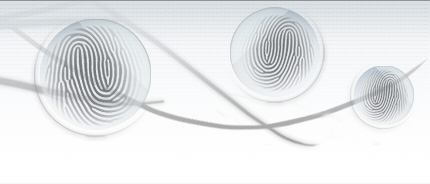

Introduction to Fingerprints
The uniqueness and permanence of the fingerprints are
very well-know. Archaeological artifacts prove that fingerprints were
already used by the ancient Assyrians and Chinese as a form of
identification of a person. The first scientific studies on fingerprints
date from the late sixteen century, but the fundamentals of modern
fingerprint identification methods were provided at the end of nineteenth
century. The studies of Sir F. Galton and E. Henry led to formally accept
fingerprints as valid signs of identity by law enforcement agencies.
The first Automated Fingerprint Identification Systems (AFIS) were
developed in the 1950s by the F.B.I. (Federal Bureau of Investigation) in
cooperation with the National Bureau of Standards, the Cornell
Aeronautical Laboratory and Rockwell International Corp. Ten years later
other AFISs were developed by NEC Technologies Inc. (Tokyo), Printrack
Inc. (Anaheim, California), and Morpho System (Paris).
Fingerprint
recognition is nowadays the basic task of the Integrated Automated
Fingerprint Identification Service (IAFIS) of the most famous police
agencies. Ten-print based identification and latent fingerprint
recognition are the two main concerns of an IAFIS. In case of Ten-print identification, the
system should identify a person by the whole sequence of his/her ten
fingerprints, in case of latent figerprint the system has to identify a person through a
fingerprint found on a crime scene. Technology advances in the 1980s in
the areas of personal computing and optical scanners triggered
non-forensic applications of fingerprint recognition methods. The enormous
interest roused by electronic commerce on Internet and, more in general,
by the need of reliable techniques for authenticating the identity of a
living person in a broad range of applications has greatly intensified the
research efforts towards the development of low cost small-size
fingerprint-based biometric systems.
Fingerprint Anatomy
A fingerprint is the representation of the epidermis of a finger. At a macroscopic analysis, a fingerprint is composed of a set of ridge lines which often flow parallel and sometimes produce local macro-singularities called whorl, loop and delta.

The number of cores and deltas in a single fingerprint is regulated in nature by some stringent rules; fingerprints are usually partitioned into five main classes (arch, tented arch, left loop, right loop, whorl) according to their macro-singularities.

The ridge-line flow can be effectively described by a structure called directional map (or directional image) which is a discrete matrix whose elements denote the orientation of the tangent to the ridge lines. Analogously, the ridge line density can be synthesized by using a density map.


At a finer analysis other very important features can be discovered in the fingerprint patterns. These micro-singularities, called minutiae or Galton characteristics, are essentially determined by the termination or the bifurcation of the ridge lines. Minutiae play a primary role for fingerprint matching, since most of the algorithms rely on the coincidence of minutiae to state whether two impressions are of the same finger or not. Minutiae matching, which is essentially a point pattern matching problem, constitutes the basis of most of the automatic algorithms for fingerprint comparison.

Fingerprint acquisition
The oldest and most known fingerprint acquisition technique is the "ink technique", that is, pressing the finger against a card after spreading the finger skin with ink; this technique is nowadays still largely used by the police in AFIS. The cards are converted into digital form by means of scanners identical to those normally employed for general purpose paper documents. The default resolution is 500 dpi. This technique can produce images including regions which miss some information, due to excessive inkiness or to ink deficiency, and is obviously limited to forensic applications. The Frustrated Total Internal Reflection (FTIR) is the most used and mature live-scan sensing technique. The finger is illuminated from one side of a glass prism with a LED, while the other side transmits the image through a lens to a CDD/CMOS sensing element which converts light into digital information. The lack of reflection caused by the presence of water particles where the ridges touches the prism allows ridges to be discriminated from valleys.



